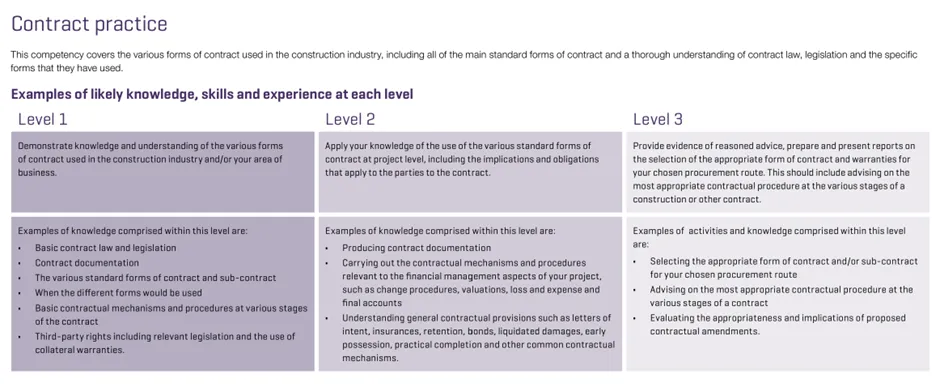
RICS APC: Contract Practice
This week’s focus is contract practice. As quantity surveyors we are, to some extent, risk managers so understanding how risk is allocated through contracts and how contracts need to be administered to protect that risk allocation is an important part of our role.
The Definition
Contract practice ‘covers the various forms of contract used in the construction industry, including all of the main standard forms of contract and a thorough understanding of contract law, legislation and the specific forms that they have used.
A snapshot of the competency description from the pathway guide is provided at Figure 1, where you will see what is required of you at level 1, level 2 and level 3. At your APC assessment, you need to demonstrate that you have achieved level 3 competency.

Remember: level 3 is advising; level 2 is doing; and level 1 is knowing. What constitutes advice? The Oxford English Dictionary defines advice as ‘guidance or recommendations offered with regard to prudent future action’.
For me, in the context of the APC, this means there was an issue, and you used your professional judgement to understand the issue and recommend to your client or your employer as to the action which should be taken.
Let’s explore this further with some hypothetical examples of contract practice.
Level 3, Bullet 1
At level 3, you are required to demonstrate that you can competently ‘select the appropriate form of contract and/or sub-contract for your chosen procurement route.
As a quantity surveyor working for a main contractor or subcontractor this can sometimes be a tricky competency to demonstrate because your selection is largely led by the form of main contract.
However, if you think a bit more about this, you will have some solid examples which are normally second nature decisions. You would not select a form of contract suitable for a supply only contract when you are procuring a subcontractor with design responsibility. Conversely, you wouldn’t use a contract ladened with design responsibility clauses for the procurement of labour supply.
These might seem obvious, but it does demonstrate that you understand the risk that is being allocated and you can advise on the selection of a form of contract that is suitable for that risk allocation.
Level 3, Bullet 2
At level 3, you are required to demonstrate that you can competently ‘advise on the most appropriate contractual procedure at the various stages of a contract’.
Again, sometimes this advice might seem obvious: you would operate the time provisions if there is a critical path delay; you would operate the variation provisions if there is a change; and you would the payment provisions to get paid.
However, there are situations where your advice will be crucial. These might include operating non-completion clauses to protect your right to deduct damages, putting in place processes to ensure you do not fall foul of any time bar clauses, or following contract processes to access insurances.
When an unfamiliar issue occurs, you will be the first port of call for the project team who need you to explain what the contract says. You might then obtain legal advice on the issue but your initial advice will give decision makers the information they need to decide on next steps (e.g. whether legal advice is needed which is advice in itself).
Level 3, Bullet 3
At level 3, you are required to demonstrate that you can competently ‘evaluate the appropriateness and implications of proposed contractual amendments’
It is not unusual for you to put out your terms and conditions with a tender and for the tendering subcontractor to propose amendments. In giving advice, what you are looking to demonstrate is that you understand the implication of the amendment and it's relevance to the agreement.
Pushing back on amendments to design related clauses for a package that has no design responsibility, for example, would not show you up in the best light, whereas resisting a request a subcontractor makes to have no liability for delay would be sensible as that subcontract can control its liability for that risk.
Final Reflections
In all three examples, you need to demonstrate that you understand contract provisions and how they operate. That doesn’t mean you need to be know these to the extent that a lawyer would, however you should show an awareness of the key clauses and the implications if they are amended and / or operated.
For me, this all comes back to knowing how risk is allocated and how that risk allocation is preserved by correctly administering the contract. As an assessor, I would be looking for you to demonstrate this competence with strong examples that show how you gave sound and reasoned advice.
In next week’s article, we will look at procurement and tendering. Keep an eye out for that and, in the meantime, enjoy the rest of your week!
Bringing The science of Quantik® to you
p.s. If anything in this article, or any of our articles, resonates with a challenge you are experiencing, check out our ‘Bringing The science of Quantik® to you’ initiative where we offer a tailor-made session aimed at helping you tackle your project or business challenge (link below).
Form: https://form.jotform.com/241425931072350
Back to articles
THE SCIENCE OF QUANTIK™
Publications
We publish insights through our LinkedIn newsletter, titled “The science of Quantik”, which are light bites of information covering news and insights relating to the construction industry and quantity surveying.
LinkedIn